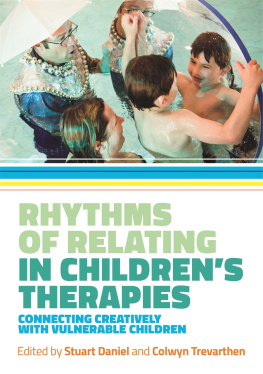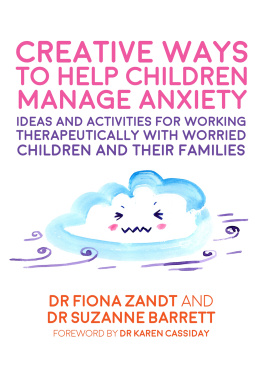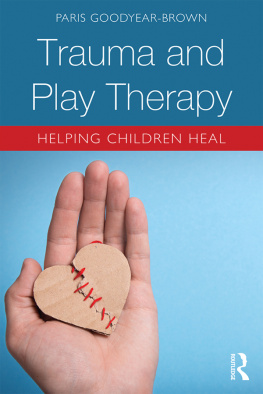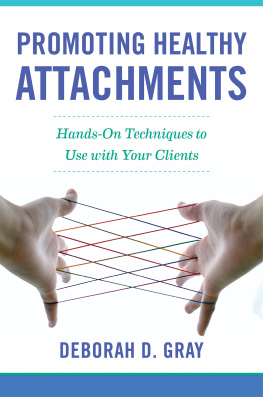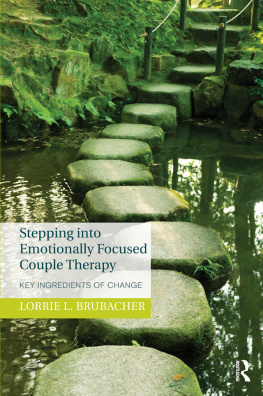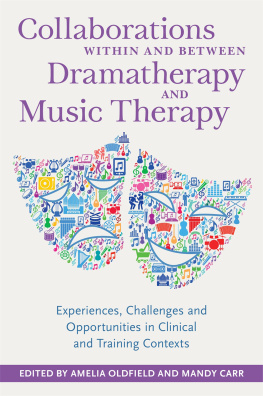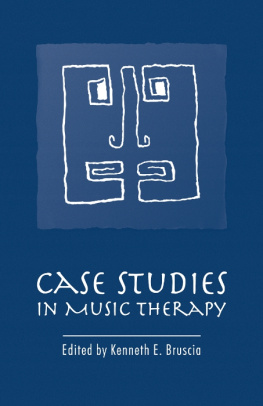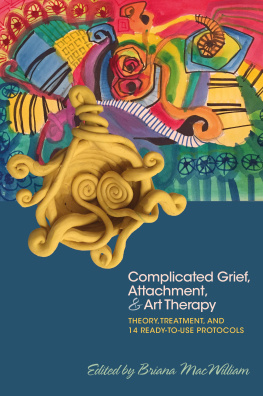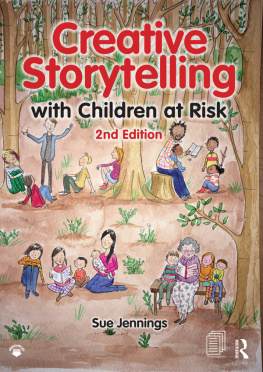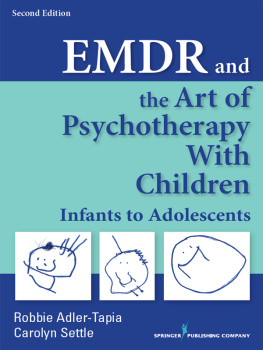
RHYTHMS
OF RELATING
IN CHILDRENS
THERAPIES
CONNECTING CREATIVELY
WITH VULNERABLE CHILDREN
Edited by Stuart Daniel and Colwyn Trevarthen

Jessica Kingsley Publishers
London and Philadelphia
In memory of Dan Stern
Note on client confidentiality and pronoun use
Throughout the book you will find many case stories involving children, parents, carers and therapists. These stories use various methods changed names, composite characters and cases, altered details to protect the identities of those involved. On the occasions where these alterations have not been made, full and written permission has been given to publish by those concerned.
Please note that contributors have sometimes used alternating pronouns to reflect client balance (and also, in some instances, they/their/them in the singular). Hence inconsistency in pronoun use is intentional on behalf of the contributors.
Donation of royalties
All author and editor royalties from this book will be donated to the National Society for Prevention of Cruelty to Children a UK based childrens charity.
CONTENTS
INTRODUCTION
Rhythm from the Beginning
STUART DANIEL AND COLWYN TREVARTHEN
Time is an odd thing. Its hard to catch. For most of us, most of the time, it seems to flow fairly consistently in a particular stream, a particular direction. On any regular day in our regular lives, our personal story of time is made standard just information from a clock. But then again, every so often that story goes a little strange.
On a Wednesday, in 2005 at 2.30 p.m., a particular zoo-keeper of Darjeeling Zoo (North East India) was preparing the meat to feed a snow leopard. The snow leopard was pacing a well-worn path along the edge of her large basin-style enclosure. She was frustrated and violently angry. The zoo-keepers slow, noisy and smelly approach to meat preparation was clearly taunting her. Her movement was raw potential. I was captivated. I was kneeling down at the edge of the basin, at the top where, in addition to the steep slope of the basin wall, there was a wire fence. The basin wall was high. High enough, I figured. From the moment she caught my eye time definitely went a bit wobbly. The snow leopard turned in her tracks, kind of folded in on herself, getting positioned to run. She took just a few soft steps and then somehow was face to face with me. I didnt understand the jump. I couldnt perceive how she was there. The wire fence between us was absolutely invisible to my mind. The detail of her cold eyes was flawless. And so was the concrete body-knowledge that her teeth were on an inevitable trajectory to my neck. Time did the long, drawn-out stretchy thing. I experienced too much, took in too many details for that moment to be part of my usual story of time. Fortunately for me, cold hard Newtonian physics kicked in and the snow leopard crashed off the invisible fence. I shuffled off, as my time re-regulated, and spent many of those standard minutes shaking with shock.
Our stories of time (based on the changeable qualities of our time perception) are dependent on the nature of our neuro-psychological individuality, on culture, on age, on mood (for instance, what we ate for lunch, or a need for sleep) and on the entire context of every single experience we have (Hammond 2013). When we begin to examine these stories, we start to question the solidity (even the logical possibility) of the basic narrative ingredients. For instance, the now something usually considered to be the instantaneous present. Playing with a simplified version of a Buddhist practice called the one or many reasoning (Burbea 2014) consider the logic of an instantaneous now. If a now has duration over time, then it of course has temporal component parts: a past, a present, a future. If it has these things then it cannot be an instantaneous now. And if it has no duration, the other possibility, then in any common sense view of time it cannot inherently exist there is literally no time for it to arise. From this perspective, being in the here and now, as they say, just doesnt make any sense. From this impossible place, we can then ask ourselves without a now how would we get our bearings on a past or a future? From where would our sense of structured time arise? If a now is impossible, would our story of time (the narrative of our entire life) simply fall away?
So what tools do we use to build our personal stories? We rely on the experience of having temporal structures wrapped up with our experience of being alive. But given that structure is not inherent in time, where does it come from?
Here, in this book, we are interested in the idea that we impute structures (like directionality, regularily, chunks of time and the now) on to the flow of time. These structures are felt through the internal and external rhythms of our bodies in motion (Goodrich 2010; Stern 2010). This felt-sense being integral to a fabrication process resulting in prospective and remembered psychological experience.
In our first chapter, Nigel Osborne takes us on a tour of the many chronobiologies (rhythms) of our human bodies. They are the sometimes hidden, sometimes felt, sometimes conscious rhythms that regulate us. We can play with the possibility of different times, each a derived sense from a different chronobiological rhythm: different pulses giving us different experiences of the passing of time; different frequencies of pulse giving us a sense of varied expectation and different durations of now (Stern 2004).
But most of all, here we are interested in how our rhythms of life are shared, how they sync up, how they can enable two or more people to connect and feel connected. We are interested in social rhythm. In identify the passionate qualities of time in early communication between infant and carer. And then, on to the potential for these qualities to bring health and happiness into relating with vulnerable children we move into the rhythms of relating in childrens therapies.
The life of this book began with this title offered as an open inspiration for many contributors from across the globe: music therapists, trauma specialists, dance movement therapists, psychobiologists, dramatherapists, explorers in music education, counsellors, play therapists, somatic therapists, specialist theatre and arts-project pioneers, composertherapists, teachers and researchers. The editors wish to thank everyone involved for their insight, passion and patience. Each contributor was invited to have fun exploring their own interpretation of our title their particular ways to phase in-sync with children who otherwise find communication and depth challenging. The results form this collection. We hope you have fun reading it.
References
Burbea, R. (2014) Seeing That Frees: Meditations on Emptiness and Dependent Arising . West Ogwell, Devon: Hermes Amara Publications.
Goodrich, B.G. (2010) We do, therefore we think: time, motility, and consciousness. Reviews in the Neurosciences 21 , 331361.
Hammond, C. (2013) Time Warped . Edinburgh: Canongate Books.
Stern, D.N. (2004) The Present Moment in Psychotherapy and Everyday Life . New York: W.W. Norton.
Stern, D.N. (2010) Forms of Vitality: Exploring Dynamic Experience In Psychology, the Arts, Psychotheraphy, and Development . Oxford: Oxford University Press.
Here, this is Stuarts personal recollection.
PART 1
THE MUSICAL ESSENCE OF HUMAN CONNECTION
LOVE, RHYTHM AND
CHRONOBIOLOGY
NIGEL OSBORNE
The origins of chronobiology: Hearts and flowers
Today, Highgate Hill is a busy thoroughfare, with public buildings, Victorian terraces and leafy spaces. In the late 17th century, however, it was largely rural, with a country mansion or two nearby, like the timber-framed Lauderdale House, and for the rest, rolling fields, copses, hedgerows and gardens. It was where the metaphysical poet, satirist and politician Andrew Marvell had a cottage and spent the latter years of his life.
Next page
